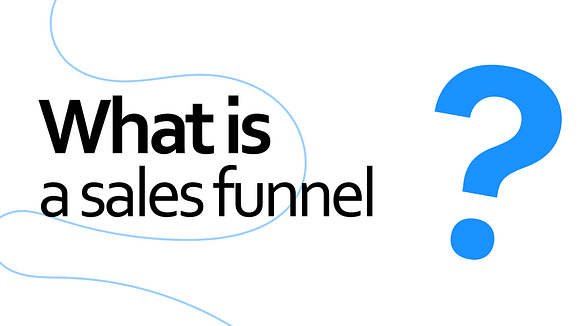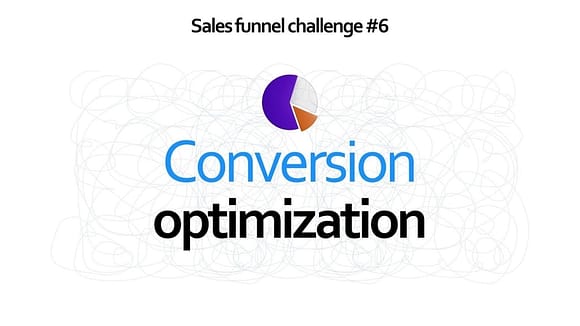
Angel Poghosyan
September 28, 2022
The sales funnel is a timeless cornerstone of marketing. But what is a sales funnel exactly? What does it do? And why should you care about it?
This article will cover all of that and more. Here, we address what a sales funnel is, how it works, its 5 stages, and the top 6 sales funnel challenges in modern marketing. Understanding these challenges is a key step in generating sales and growing your business.
Let’s get right into it.
A sales funnel is a marketing model that refers to the journey prospective clients go through that will hopefully and ultimately lead to a final sale. The sales funnel represents each step that a person has to take in order to become your customer.
The components of a sales funnel can seem abstract, so let’s take a look at a brick-and-mortar sales funnel example.

The people at the top of the funnel are the ones who walk by your store. Maybe some are just passing by or even window-shopping. When a person decides to enter your store, they pass into the next stage of your marketing and sales funnel.
A customer is browsing and stops at a “New Collection” shelf to peruse the products. Now, they’re at the next step of the funnel. When the customer takes those products to the check-out counter and makes a final purchase, they reach the bottom of your sales funnel.
The main purpose of a sales funnel is to guide your potential customers through a journey that optimizes their chances of converting into a customer.

This diagram demonstrates the many benefits of a sales funnel. Understanding the flow of consumers is important in understanding how your marketing team can make use of different types of funnels.
Any marketing channel can be a part of your sales funnel. The different types of funnels can be spread across various channels such as:

The various sales funnel stages may differ depending on which channel you are using it for. But if used correctly, the benefits of a sales funnel marketing strategy are universal across all boards.
In marketing, the main components of a sales funnel are easily described by the acronym AIEDA. So, let us show you what are the 5 stages of sales funnels.
Awareness is the stage of using your marketing channels to target key audiences. This usually involves studying your audience and learning how to attract them. How can you widely market your products or services to make them well-known? What is your outreach strategy?
Interest is gained by anticipating the needs and wants of your target audience. This stage of the funnel is among the most common sales funnel challenges. It takes a great marketing plan to gain interest, and lucky for you, Cloud9 has a guide for that!
Evaluation is the stage where your prospects are considering your offer and comparing it with different alternative options. More specifically, they’re looking at features, pricing, reviews, and testimonials. This is where your value proposition will convince them to choose your product over others.
The goal of this stage of the sales funnel is to convert your audience into prospective clients. The desire part of the funnel transforms their disposition of “I know about this product” to “I need this service.”
And there you have it – all 5 sales funnel stages explained.
To get more of your audience to the “Desire” stage of the funnel, it’s important that you push out interactive and trustworthy content.
Prospects will start to engage with your brand and see that it’s something worth investing in. Publishing testimonials is a best practice when it comes to helping more prospects advance into this stage of your sales funnel.
You’re so close to sealing the deal! This final “action” stage is the final nudge that’ll get your prospects from appreciating your product or service from afar to becoming a loving user.
You’ve already done tremendous amounts of work in the marketing stage, and now it’s time for a call to action (CTA). Different types of funnels require different CTA’s; you may benefit from sending out an email, making a phone call, or even prompting your audience to schedule a consultation.
Further down the funnel, especially funnels concerning e-commerce, consider offering discounts or free shipping to seal the deal. Use a CTA technique that is consistent with your previously determined marketing plan.
Learning the theory behind a sales funnel is one thing, but creating a funnel for your own business is a different story. So, now that you know what is a sales funnel, let us show you a step-by-step process of how to create a sales funnel.
Once you have your sales funnel in place, you’ll need to constantly measure its effectiveness and optimize. Here are some aspects of a sales funnel that you’ll need to manage and how:
To fully understand what is a sales funnel, you also need to understand its ins and outs. A huge factor here is tracking the results you get with it. So, you should use Google Analytics, Search Console, and other analytics tools. This way, you’ll be able to see what’s working and what isn’t.
Understanding which of your leads are more likely to convert is crucial. It’ll help you figure out when they’re ready to move on to the next stage and adjust your strategy accordingly.
The last step of understanding what is a sales funnel is optimization. After all, you can’t set it and forget it.
From all the analytics and results, you’ll be able to determine what modifications you need to make in order to optimize your sales process.
Don’t be afraid to experiment with new sales strategies.
Different types of funnels present different challenges, but understanding these top sales funnel challenges will help influence how users navigate through the funnel and whether they convert.
After understanding what is a sales funnel, it’ll be time to understand its benefits and challenges.
The most prominent sales funnel challenges will prevent your prospects from becoming clients. That’s why we’ve outlined 6 of the biggest sales funnel challenges and how to tackle them.
So, what are the biggest sales funnel challenges? Let’s dive right in and uncover the 6 biggest difficulties people face when developing and using a sales funnel.
A lead generation funnel is one of the few different types of funnels. Generating enough leads and traffic using this method is among one of the most common sales funnel challenges.

Although your sales funnel may be efficient in converting leads, you may have difficulties bringing enough people into your funnel, aka generating enough traffic.
The first step to generating prospects and traffic is to understand your prospective client’s journey. You can do so by utilizing Google Analytics to pull data on users who have interacted with your brand. But don’t forget, it’s not always about the numbers.
With the next step, you have to create relevant content that entices your audience. Be original, be tactful, and be intentional.
Drive content using an SEO strategy, splurge on paid ads, take advantage of your socials. Do what it takes to drive traffic.
You’ll learn more about what is a sales funnel during the process of actually using it and generating prospects.
Keeping your sales funnel short is one of the most common sales funnel challenges. The process of getting prospects to successfully progress through your sales funnel system can be lengthy. If that process is too long, people will drop out of the funnel, leading to the loss of sales.

Here are Cloud9’s tips to keep your sales funnel short but sweet! (And effective)
The third challenge that comes along with learning what is a sales funnel is differentiation. The truth of the sales industry is that you have an immeasurable amount of competitors. Even if your product or service really is the best out there, you’ll probably still strike out to a competitor at one point or another.

Standing out against the competition starts as early as the “Awareness” and “Interest” stages of the funnel. Utilize a strong marketing plan to ensure a wider reach. And when you do reach your target audience, your content better be stellar!
Creating content that sells will help you tackle the sales funnel challenges that are preventing prospects from turning into clients, and you’ll ultimately master your understanding of what is a sales funnel.

The aim of your content is to win people over; convert people to your brand; show them your personality, your creativity, and your goodness.
If you’re selling a service rather than a product, you can instead utilize the Instagram guide feature. Posting SEO related guides, for example, is genuinely helpful content that will be appreciated by your fellow SMM audience. Appreciation leads to loyalty, and in turn, sales.
So you finally have the greatest content you’ve ever put out there. You’re generating traffic and leads, and even more sales than you’ve ever seen.
But…
Your customer service isn’t hitting the mark.

Long response times, rude customer support, late deliveries, sketchy/laggy websites, unreasonable return/exchange policies. These are all things that will completely delegitimize all of the hard work you’ve put in prior to making the sale.
Be consistent with your overall functions and processes, even those that are unrelated to marketing.
Risk is inevitable when learning about what is a sales funnel. At every stage, you risk your prospect leaving the funnel. The flow of a sales funnel is a trial and error process. But once you start to understand how your clients interact with your brand, you can start finding the holes in your sales funnel.

At what stage of the funnel do your prospects drop out? Finding your bottleneck is a critical point in adapting your technique to convert prospects into clients. If you have a lot of leads but a below-average conversion, consider these 3 points:
Understanding what is a sales funnel is a learning process. You’ll learn best through practice! So, take all the theory we’ve taught you today and get to work.
If you’ve encountered any of the sales funnel challenges we talked about, know that you’re not alone. While it can seem somewhat perplexing, the sales funnel isn’t a total enigma.
Once you understand the filtering process of the funnel, you can identify leaky points in your own sales funnel model. Chances are, targeting and adjusting these shortcomings will lead to greater success in converting prospects into leads and, eventually, clients.
We wish you the best of luck on your sales funneling journey! Don’t forget to bookmark this tab in case you ever find yourself in a (non-kitchen related) funnel crisis.

6+ years of doing content, marketing, and strategy for startups & businesses. Specializing in social media, entertainment, and tech.
Thank you for exploring our knowledge base. If you’re interested in applying expert techniques and strategies to skyrocket your business, let’s talk.
Signup for news and special offers!
You have successfully joined our subscriber list.